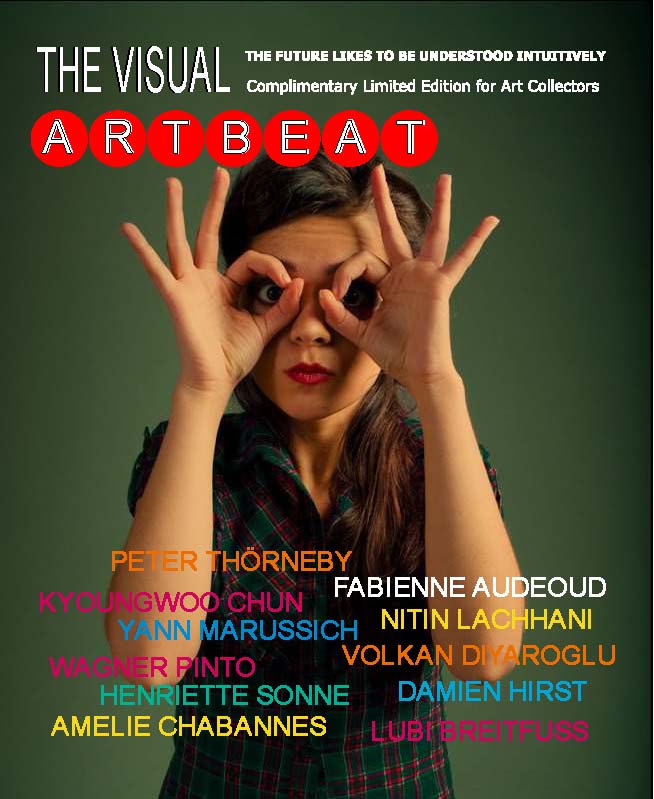
download the magazine ———>
The Art of
Volkan DIYAROGLU
By Nicholas Forrest
When I was asked to write this article about the work of the 27 year old Turkish born, Spain
based artist Volkan Diyaroglu I was excited and honoured because Volkan is one of the most
talented artists I have ever come across. An artist whose use of colour and form suggests a
heightened visual-spatial intelligence and an extra-sensory perception of the visual language.
However, no matter what I write I cannot do his work justice because it is not the sort of work
that should be written about, it is the sort of work that should be experienced. Neither can I
really explain his work as it is the result of a process that even the artist himself cannot
explain – a process where Volkan surrenders himself to his work and allows intuition to guide
his every move. It is a very personal and intimate process which is driven by the subconscious
mind and is more about the artists own journey than anything else.
Just like with a piece of music, Volkan’s paintings take you on a journey that can evoke
emotional and psychological reactions even though you have no idea why or for what purpose
those reactions are being evoked. In order to appreciate or enjoy a piece of music one does
not have to know who the composer was, what the music is about or, for that matter, anything
about the piece of music what so ever. If you or I were to hear a piece of music that we had
never heard before and knew nothing about, we would still be able to experience and
appreciate that piece of music on a purely sensory level. In much the same way, Volkan’s work
is to be experienced on a purely sensory level.
It is normal for the viewer of a work of art to search for an ultimate truth or an obvious
meaning in an image as that is what our minds are trained to do, but as an abstract
artist in the purest sense, Volkan produces paintings that defy logic and reject reality.
There is nothing wrong with looking for an answer or a meaning in Volkan’s paintings
as long as you do not expect to find what you are looking for because, with his work,
there is no ultimate truth, and no beginning or end. The characteristic array of shapes
and colours that form the basis of Volkan’s paintings are the culmination of a series of
thoughts, feelings and movements. Each individual form represents a moment of
meditation which is the product of what has been, and an influence on what is to come.
Each painting represents a period of time during which Volkan surrenders himself to
the moment and immerses himself in his own thoughts and feelings. During that
time, the artist exhibits what I can only describe as an amazing ability to translate
his thoughts and feelings into colours and forms. It is these colours and forms that
engage the sub-conscious of the viewer and make his work so engaging.
Just like his latest body of work which includes works with titles such as
‘Catastrophe’, ‘A Beautiful Bomb’ and ‘Hortum’ (Turkish for Tornado), Volkan’s
paintings are spontaneous and chaotic events that have a momentary effect on the
participant’s perception of time and space. At first the viewer may be overwhelmed by
the chaos and energy, but the hypnotic qualities of Volkan’s paintings encourage the
viewer to surrender themselves to the experience and go beyond the purely visual.
An endless number of possibilities are available to the viewer, with each movement
of the eye revealing yet another path to follow and another experience to be had.
You might even come across one of the faces or familiar forms that are sometimes
hidden in his works. These familiar elements evoke a momentary sense of
disorientation and uncertainty during which the viewer is suspended between two
alternate realities. As to which reality is the true reality, well, that is up to you.
I think that the final word should come from the artist himself so here is a quote by
Volkan taken from a recent interview: “When we look at something, depending on
our point of view, we may find something beyond what’s represented, or not. That’s
something about ourselves, not something in the work, or in the objects or things that
we believe exist. What I know is I don’t lie when working on a canvas, and this attitude
doesn’t permit me to understand my paintings, what more can I say, my painting
represents all that has happened, all that will happen, all that can or could happen in
the moment that it is created and in the space that it is created”
END
**Nicholas Forrest is an art market analyst, art critic and journalist based in Sydney,
Australia. He is the founder of http://www.artmarketblog.com, writes the
art column for the magazine Antiques and Collectibles for Pleasure and Profit and
contributes to many other publications.
